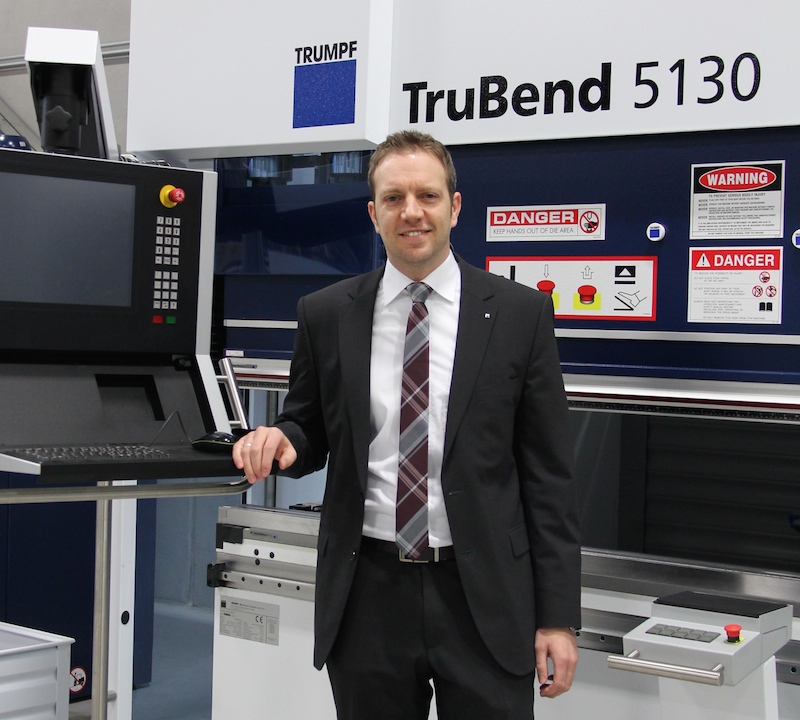
Jun. 27, 2016 – It has been just over one year since Stefan Fickenscher took on the role as Trumpf Canada managing director — Manufacturing AUTOMATION sat down with him to find out how the past year has gone.
MA: How would you describe your experience as the managing director of Trumpf Canada?
SF: Besides the fact that it’s hard to believe it has already been a year, the last 12 months were really challenging at times but were mainly full of new opportunities. We, as a company, continuously try to improve and give our customers the best possible customer service experience, and within the past year, we started different initiatives, like in our spare parts area or service department. By using feedback from our customers, we have introduced new processes or technologies that we hope will make their life easier. It [has been] really exciting and satisfying. Trumpf Canada is a relatively small subsidiary with a little more than 30 employees. As a comparison when I worked in the U.S., we had about 700 and at the German headquarters when I started with Trumpf, we already had more than 2,000 people working there at that time. This results in everybody [here] having to wear several different hats and being true ‘all rounders.’
MA: Your appointment was announced at the grand opening of the relocated Mississauga, Ont., office last April. What response has the new facility gotten so far?
SF: We’re really happy that we can permanently demonstrate our equipment with our new showroom, this is something we couldn’t do before. It has been a big success, especially for customers within a two- to three-hour driving distance. It’s much easier for customers to come in for a one-day trip to [check out] and test our machines, instead of flying to [our showrooms in] Connecticut or Germany. It brings our customers much closer to us and us closer to them. A lot of our customers, I would say around 80 per cent, are small job shop companies and a lot of times when they invest in equipment, it is the biggest investment they’ve ever made in their life. There’s a big trust factor involved and the relationship between the customer and the supplier is very important. Having the possibility to just quickly come in and spend time [face to face] strengthens this relationship.
MA: Before taking on this position, you worked in Germany and the United States. What differences have you noticed between the various manufacturing industries?
SF: From my experience, it’s always very helpful to see different organizations or countries as it gives you the opportunity to benchmark and improve your own organization. The trend towards automated systems started early in Germany before starting here in Canada or North America. When you look at German manufacturing plants, you see shops that are using load-unload systems and have machines completely attached to storage systems that run 24/7 unmanned and it seems like a lot of smaller [operations] here are slowly [incorporating] automation and that has been quite interesting to see. Something I really like about Germany — and I think this is a part of its success — are the apprenticeship programs where students get trained for three or four years; they work in factories but about 50 per cent of their time is spent in schools. They are getting prepared to become experts in their particular field. With these programs, the students can immediately work in the factories [after completion] and are quite efficient, and as a result, the supply of skilled workers on the production floor is guaranteed. This is something that we see all over the place back in Germany and here in Canada, some of the bigger companies are now starting systems like that. It’s an approach that I think is very successful.
MA: How would you rank Canada’s strength in manufacturing on a global level?
SF: We know that the Canadian manufacturing sector has quite an impact on Canada’s overall prosperity but it really does not play a significant role on the global stage. Canada needs to follow the global trends we see at the moment. We [need] to raise the bar by investing in technology and productive capital equipment to increase [our] efficiency and productivity — this is a critical factor for long-term economic success. The big topic for the next few years is the division and execution of the smart factory, and Industry 4.0 is a big part of that. We require self-regulating and self-learning systems for all processes in which high productive and high-quality machines produce parts automatically. With the Internet of Things, systems will communicate and cooperate with each other in real time and will even make decisions by themselves, and machines will be able to predict component failures in advance and can ask for maintenance without any kind of human interference. These are global trends that will bring new opportunities to Canadian manufacturing and will allow us to gain greater significance on an international scale. I think our biggest challenge is staying competitive globally, but I’ve been to many presentations and events here on [the smart factory] and based on discussions with our customers here, there is a lot of interest in this topic, so I’m positive [Canada] will not fall behind in this respect.
CLICK HERE to watch our video from the 2015 grand opening of Trumpf Canada’s relocated office.
This profile was originally published in the May 2016 issue of Manufacturing AUTOMATION.
Advertisement
- Bringing Lean to Tree Island Steel
- Finding value: How a strong employee-customer connection will improve productivity
